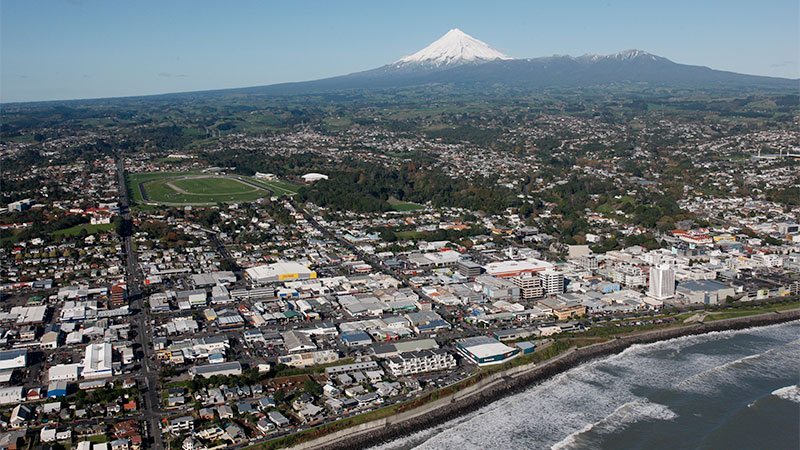A Mecca for trampers, climbers and surfers alike, New Plymouth is set in an environment that offers the best of the natural wonders these enthusiasts seek. With the extremes of surf and snow, Taranaki is certainly blessed with an unusual beauty rarely found in other parts of the world. The majestic volcanic cone of Mt Taranaki provides an incredible backdrop to the stunning coastline famous for it’s scenic splendour, and the consistent surf crashing in from the Tasman Sea.
The natural attractions in the region have boosted the international profile of tourism in recent years. Like other pockets lying ‘off the beaten track’, the area has become home to a plethora of potters, craftspeople and other artists providing a large range of galleries and studios to explore. A microcosm of the best, discover the magnificent contrasts of mountains, rivers bush, surf, sea, sand, walkways, paths and gardens.
Mt Taranaki, the ‘most climbed mountain’ in New Zealand, provides safe access to skiing, tramping, climbing and photography. Looking remarkably like Mt Fuji in Japan, the cone rises 2518m, is surrounded by lush green countryside and feeds over 50 rivers and steams. One of the wettest spots in the country (7000mm annual rainfall), the mountain has created a unique botanic environment perfect for sub-tropical forestation, sub alpine herb fields and a wide variety of native and introduced vegetation. This in turn attracts the many bird species that can be observed in the National Park and surrounding areas.
Popular with skiers in the winter, the mountain can be easily climbed in one day during summer months. Two main routes to the summit vary in degree of difficulty given the ice that remains on the south side. The principle hazard in attempting to climb the peak, or to walk the many base tracks is the erratic weather conditions. Without warning, a clear, blue, sunny day can turn into a raging gale with whiteout conditions. Considered to be relatively easy, Mt Taranaki has claimed over 50 lives – it is important to be well prepared, carry the correct maps and equipment, and report your tramping intentions to a (DOC) office. Guide companies operate in the area, so it may be wise to elect to participate in a guided climb! There are several DOC huts in the park and nearby lodges and guesthouses offer ample places to stay, ensuring your visit is a safe and relaxed experience.
The opposite extreme would be to try diving at the Sugar Loaf Islands Marine Park! A refuge for seabirds, NZ fur seals and marine life, the islands host a number of activities including boating, sailing, diving, bird watching, pole fishing, surfing and beach walks. A world-class surfing and windsurfing haven, Fitzroy and East End beaches are at the eastern side of New Plymouth. Paritutu and Oakura can be easily hitched to and are found 15km west of the city. Surf shops rent out boards, offer instruction, and provide the latest updates on conditions and forecasts.
Famous for its superb parks and annual Rhododendron Festival, New Plymouth is a gardeners delight! Pukekura Park is well worth visiting with 49 hectares of gardens, bush walks, streams waterfalls, ponds and a café. The lights and decorations in the grounds during December and January are a must see! Brooklands Park adjoins Pukekura and includes a 2000-year-old puriri tree, 300 different varieties of Rhododendron and a children’s zoo. Kawaroa Park, on the waterfront, is also home to the aquatic leisure centre with heated indoor and outdoor pools with waterslides and wave machine!
The Taranaki Museums is extremely good with superb collections of Maori artefacts, whale and moa skeletons, and old painting and etchings – some dating back to the early 1800’s. For art lovers and critics, The Govett-Brewster Art Gallery has a good reputation for its adventurous shows. It also houses a permanent display of work by the internationally renowned artist and filmmaker Len Lye.
Recognised by New Zealanders as important for the supply and distribution of petrochemicals and energy, the local economy also boasts agriculture with a strong dairying emphasis as well as aquaculture, floriculture, horticulture and forestry. Port Taranaki is the only deepwater port on New Zealand’s west coast and is one of the county’s largest.
With venues capable of seating up to1000 delegates, and centrally situated between Auckland and Wellington, New Plymouth is a perfect location for cost effective conferences. Accommodation here easily caters for the corporate visitor and the holidaymaker. Be it central city or a unique natural setting at the base of the mountain, New Plymouth offers a variety of options; hostels, campgrounds, Bed & Breakfasts, homestays, farmstays, hotels, self-catering motels and lodges. Food and entertainment is consistent with that offered in other small centres – always a huge variety, some good, some not so good!
The highlights of any visit to this colourful and diverse region would have to be walking and climbing the awe-inspiring Mt Taranaki Volcano, visiting the many historical sites, windsurfing or surfing, and relaxing in immaculate gardens. Seemingly ideal for adventure seekers, the history and vibrancy of the area is interesting to all.


Leave A Comment